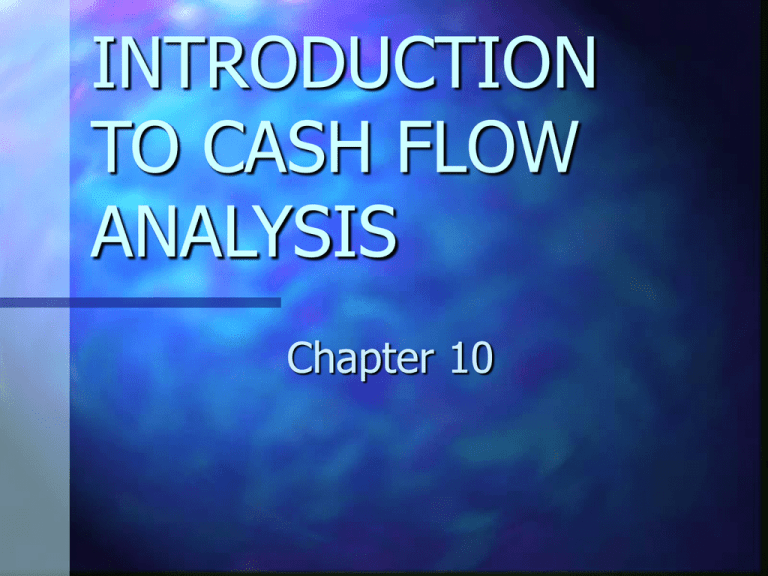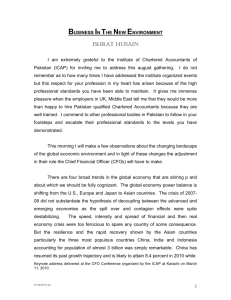INTRODUCTION TO CASH FLOW ANALYSIS
advertisement

INTRODUCTION TO CASH FLOW ANALYSIS Chapter 10 CHAPTER 10 OBJECTIVES Explain the relationships between operating, investing, and financing cash flows and stages in the business life cycle. Convert indirect CFOs to direct CFOs. Describe the significance of cash received as a percentage of revenues and paid as percentage of cost of goods sold to business operations. CHAPTER 10 OBJECTIVES (CONT.) Discern stability, efficiency, and inefficiency in an entity’s operating cash flows and liquidity measures. Analyze a company or industry’s CFOs. THE OBJECTIVE OF CASH FLOW ANALYSIS An evaluation of past events and present conditions so that the amount, timing, and probability of future cash flows can be forecast Analyst seek to understand Cash flows into and out of an entity The primary sources and uses of cash Relative consistency of cash flows over time BUSINESS DECISIONS AND CASH FLOWS Business success depends on an entity taking in more cash in its life than it pays out over time Initial cash flows Provided by debt and equity investors Used to acquire productive assets Reflect managerial decisions about how to maximize wealth BUSINESS DECISIONS AND CASH FLOWS (CONT.) The Financial Accounting Standards Board’s perspective Requires that companies disclose a statement of cash flows The cash flow statement should provide equity investors and creditors with information to make judgments about the Amount of future cash flows Timing of future cash flows Uncertainty of future cash flows BUSINESS DECISIONS AND CASH FLOWS (CONT.) Cash flows and corporate life An entity’s life cycle stage affects cash acquisitions and disbursements The life cycle stages are (Exhibit 10-1) Emergence Growth Maturity Decline BUSINESS DECISIONS AND CASH FLOWS (CONT.) Cash flow relationships to life cycle stages (Exhibit 10-2) Operating activities Outflows during emergence and early growth Inflows peak during maturity Inflows decrease (trending toward zero) in decline BUSINESS DECISIONS AND CASH FLOWS (CONT.) Financing activities Inflows during emergence and growth Outflows during late maturity and decline (i.e., the return of investment) Investing activities Outflows during emergence and early growth Inflows during late maturity Decreasing cash inflows during business decline CASH FLOWS FROM OPERATING ACTIVITIES The most important part of cash flow statement Reports the difference between cash received and paid for conducting core business activities Less subjective than accrual-based disclosures Analyst must determine the sustainability of operating cash flows CASH FLOWS FROM OPERATING ACTIVITIES (CONT.) Direct method The superior method of reporting Reports cash collected from revenues and cash paid for operating expenses Easy for financial statement users to understand Companies do not disclose CFOs on a direct basis CASH FLOWS FROM OPERATING ACTIVITIES (CONT.) Indirect method The inferior method of reporting Reconciles net income to operating cash flows Hard for financial statement users to understand Companies disclose CFOs on an indirect basis CASH FLOWS FROM OPERATING ACTIVITIES (CONT.) Converting indirect operating cash flows to direct operating cash flows Procedure for producing direct CFOs from the indirect ones reported by companies An analyst lists each revenue and operating expense category Each income statement account is adjusted for changes in balance sheet accounts (e.g., accounts receivable changes affect cash collected from sales) CASH FLOWS FROM OPERATING ACTIVITIES (CONT.) Converting indirect operating cash flows to direct operating cash flows (cont.) Certain operating expense categories are adjusted for non-cash expenses (e.g., deprecation) Cash collected from sales minus cash paid for each expense category determines direct cash flows CASH FLOWS FROM OPERATING ACTIVITIES (CONT.) Direct CFOs are more informative than indirect CFOs Analyst can directly see how much cash was received from continual activities in a reporting period Analyst can directly see how much cash was paid for continual activities in a reporting period eSTUFF’S DIRECT CASH FLOWS eSTUFF's Direct Cash Flows Sales revenue Change in accounts receivable Cash received from customers Cost of goods sold Change in inventory Change in accounts payable Cash paid to suppliers 2003 $1,310 15 1,325 2002 $1,240 (35) 1,205 2001 $1,200 (20) 1,180 2000 $1,000 (120) 880 800 65 (30) 835 719 20 (30) 709 660 50 110 820 600 200 (160) 640 eSTUFF’S DIRECT CASH FLOWS eSTUFF's Direct Cash Flows Selling and administrative expenses Change in prepaid expenses Change in accrued liabilities Less: depreciation and amortization Cash paid for operating expenses Tax expense Change in taxes payable Cash paid for taxes Financial expense Change in interest expense Cash paid for interest 2003 505 (4) 3 (141) 363 2002 462 7 (22) (125) 322 (6) 6 16 (6) 10 14 5 19 22 (5) 17 20 20 20 10 - $ 20 $ 2001 485 (5) 29 (125) 384 20 $ 2000 335 10 (50) (105) 190 20 $ 10 eSTUFF’S CFO RECONCILIATION eSTUFF's CFO Reconciliation CFOs--Indirect Method (as reported) CFOs--Direct Method (as computed) Cash received from customers Cash paid: To suppliers For operations For taxes For interest Net cash provided by operating act. 2003 2002 2001 2001 $107 $144 ($63) $23 $1,325 $1,205 $1,180 $880 (835) (363) (20) $107 (709) (322) (10) (20) $144 (820) (384) (19) (20) ($63) (640) (190) (17) (10) $23 CASH FLOWS FROM OPERATING ACTIVITIES (CONT.) Drawbacks of direct CFOs Conversion process takes time Judgment is often required in classifying and adjusting accounts INTERPRETING CFOs Analysts judge how well an entity performs its core business activities Cash flows from operating activities provide numerous insights The focal point is operating cycle activity Cash collected on sales Cash paid for inventory INTERPRETING CFOs (CONT.) Operating cycle cash flows are classified in three categories (Exhibit 10-4) Stable operations Cash collected from customers as a percentage of sales remains constant over time Cash paid to vendors as a percentage of cost of goods sold remains constant over time INTERPRETING CFOs (CONT.) Efficient operations Cash collected from customers as a percentage of sales increases over time Cash paid to vendors as a percentage of cost of goods sold decreases over time Inefficient operations Cash collected from customers as a percentage of sales decreases over time Cash paid to vendors as a percentage of cost of goods increases over time INTERPRETING CFOs (CONT.) Operating cash flow and trends Trend data increases insights about operating cycle cash flows (Exhibit 10-5) Trends are sometimes difficult to deduce for existing companies INTERPRETING CFOs (CONT.) Relationships between operating cycle cash flow and short-term liquidity measures (Exhibit 10-6) Reports the direction of change (increase or decrease) for Inventory activity measures Accounts receivable activity measures Accounts payable activity measures INTERPRETING CFOs (CONT.) Changes in these activity measures can be applied to Stable operations Efficient operations Inefficient operations INTERPRETING CFOs (CONT.) Forecasting operating cash flows Uses operating cash flow history and trends to predict the future Incorporates short-term liquidity analysis into the assessment Knowledge of other areas of analysis (e.g., operating performance) assists in cash flow forecasts APPLE COMPUTER AND THE PC INDUSTRY Company is in its late growth or early maturity life cycle stage Focus of the operating cash flow analysis is on the cash provided by and used for making and selling PCs APPLE COMPUTER AND THE PC INDUSTRY (CONT.) Industry cash flows Industry demonstrated strong operating cash flows from 1993 to 1998 (Exhibit 107A) Industry’s cash flows were less than stable over time Compaq’s poor performance reduced operating and net cash flows in 1998 (Exhibit 10-7B) Exhibit 10-7 Composite Cash Flows 1993-1998 (in millions of dollars) 6000 5000 (A) Cash Flow Activites 4000 3000 2000 1000 0 -1000 1993 1994 1995 1996 -2000 -3000 -4000 -5000 CFO CFI CFF 1997 1998 APPLE COMPUTER AND THE PC INDUSTRY (CONT.) Apple Computer’s direct operating cash flows Apple’s indirect operating cash flows were converted to a direct basis to improve interpretation (Exhibit 10-8) The company reported positive CFOs during the period analyzed APPLE COMPUTER AND THE PC INDUSTRY (CONT.) Cash flows were positive because of Apple’s Return to profitability Continued reductions of inventory Favorable changes in the account balances of current assets and restructuring costs APPLE COMPUTER AND THE PC INDUSTRY(CONT.) Operating cycle cash flows Industry data was analyzed from 1994 to 1998 (Exhibit 10-9) Dell and Gateway demonstrated stable operating cash flows during that time period Apple and Compaq’s collection on sales and payments to vendors were erratic Compaq’s paid a higher percentage on its cost of goods sold than it collected on its sales Apple collected more than 100% of revenues in cash (a trend that cannot continue) Exhibit 10-9b Cash Received as a Percentage of Revenues 1994-1998 110.00% 100.00% 90.00% 80.00% 1994 1995 Apple 1996 Compaq 1997 Dell Gateway 1998 Exhibit 10-9c Cash Paid as a Percentage of Cost of Goods Sold 1994-1998 110% 105% 100% 95% 90% 85% 80% 1994 1995 Apple 1996 Compaq 1997 Dell Gateway 1998 APPLE COMPUTER AND THE PC INDUSTRY(CONT.) Operating cash flow data support the analysis of short-term liquidity Dell and Gateway are more liquid than Apple and Compaq Dell’s and Gateway’s operations are more stable than those of Apple and Compaq Apple’s inability to sell computers profitability results in its lagging the industry





